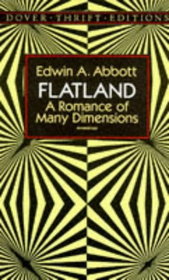 Unless you’re a mathematician, the chances of you reading any novels about geometry are probably slender. But if you read only two in your life, these are the ones. Taken together, they form a couple of accessible and charming explanations of geometry and physics for the curious non-mathematician. Flatland, which is also available under separate cover, was published in 1880 and imagines a two-dimensional world inhabited by sentient geometric shapes who think their planar world is all there is. But one Flatlander, a Square, discovers the existence of a third dimension and the limits of his world’s assumptions about reality and comes to understand the confusing problem of higher dimensions. The book is also quite a funny satire on society and class distinctions of Victorian England. The further mathematical fantasy, Sphereland, published 60 years later, revisits the world of Flatland in time to explore the mind-bending theories created by Albert Einstein, whose work so completely altered the scientific understanding of space, time, and matter. Among Einstein’s many challenges to common sense were the ideas of curved space, an expanding universe and the fact that light does not travel in a straight line. Without use of the mathematical formulae that bar most non-scientists from an understanding of Einstein’s theories, Sphereland gives lay readers ways to start comprehending these confusing but fundamental questions of our reality.
Unless you’re a mathematician, the chances of you reading any novels about geometry are probably slender. But if you read only two in your life, these are the ones. Taken together, they form a couple of accessible and charming explanations of geometry and physics for the curious non-mathematician. Flatland, which is also available under separate cover, was published in 1880 and imagines a two-dimensional world inhabited by sentient geometric shapes who think their planar world is all there is. But one Flatlander, a Square, discovers the existence of a third dimension and the limits of his world’s assumptions about reality and comes to understand the confusing problem of higher dimensions. The book is also quite a funny satire on society and class distinctions of Victorian England. The further mathematical fantasy, Sphereland, published 60 years later, revisits the world of Flatland in time to explore the mind-bending theories created by Albert Einstein, whose work so completely altered the scientific understanding of space, time, and matter. Among Einstein’s many challenges to common sense were the ideas of curved space, an expanding universe and the fact that light does not travel in a straight line. Without use of the mathematical formulae that bar most non-scientists from an understanding of Einstein’s theories, Sphereland gives lay readers ways to start comprehending these confusing but fundamental questions of our reality.
Excerpt from the e-book:
Part I
This World
Of the Nature of Flatland
I call our world Flatland, not because we call it so, but to make its nature clearer to you, my happy readers, who are privileged to live in Space.
Imagine a vast sheet of paper on which straight Lines, Triangles, Squares, Pentagons, Hexagons, and other figures, instead of remaining fixed in their places, move freely about, on or in the surface, but without the power of rising above or sinking below it, very much like shadows–only hard with luminous edges–and you will then have a pretty correct notion of my country and countrymen. Alas, a few years ago, I should have said “my universe:” but now my mind has been opened to higher views of things. In such a country, you will perceive at once that it is impossible that there should be anything of what you call a “solid” kind; but I dare say you will suppose that we could at least distinguish by sight the Triangles, Squares, and other figures, moving about as I have described them. On the contrary, we could see nothing of the kind, not at least so as to distinguish one figure from another. Nothing was visible, nor could be visible, to us, except Straight Lines; and the necessity of this I will speedily demonstrate.
Place a penny on the middle of one of your tables in Space; and leaning over it, look down upon it. It will appear a circle.
But now, drawing back to the edge of the table, gradually lower your eye (thus bringing yourself more and more into the condition of the inhabitants of Flatland), and you will find the penny becoming more and more oval to your view, and at last when you have placed your eye exactly on the edge of the table (so that you are, as it were, actually a Flatlander) the penny will then have ceased to appear oval at all, and will have become, so far as you can see, a straight line.
The same thing would happen if you were to treat in the same way a Triangle, or a Square, or any other figure cut out from pasteboard. As soon as you look at it with your eye on the edge of the table, you will find that it ceases to appear to you as a figure, and that it becomes in appearance a straight line. Take for example an equilateral Triangle–who represents with us a Tradesman of the respectable class. Figure 1 represents the Tradesman as you would see him while you were bending over him from above; figures 2 and 3 represent the Tradesman, as you would see him if your eye were close to the level, or all but on the level of the table; and if your eye were quite on the level of the table (and that is how we see him in Flatland) you would see nothing but a straight line
 Download “Flatland: A Romance of Many Dimensions” by Edwin A Abbott for your Kindle:
Download “Flatland: A Romance of Many Dimensions” by Edwin A Abbott for your Kindle:
“Flatland: A Romance of Many Dimensions” by Edwin A Abbott [.mobi file]